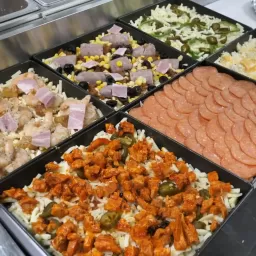Korean Noodle
Korean noodle cuisine is rich and diverse, featuring a wide variety of noodle dishes that vary in flavor, texture, and preparation methods.
 Food & Cuisine:
Korean Food and Cuisine are known not only for their taste but also for their health benefits, emphasis on seasonality, and the communal dining experience.
Food & Cuisine:
Korean Food and Cuisine are known not only for their taste but also for their health benefits, emphasis on seasonality, and the communal dining experience.
Korean noodle cuisine is rich and diverse, featuring a wide variety of noodle dishes that vary in flavor, texture, and preparation methods. Some of the most popular Korean noodle dishes include:
-
Japchae (잡채):
- Description: Japchae is a savory and slightly sweet dish made with stir-fried glass noodles (usually made from sweet potato starch) and an assortment of vegetables like spinach, mushrooms, carrots, and bell peppers. It often includes thinly sliced beef or other proteins, and it is seasoned with soy sauce and sesame oil.
- Texture: The glass noodles in Japchae are known for their smooth and chewy texture.
-
Naengmyeon (냉면):
- Description: Naengmyeon is a popular Korean cold noodle dish typically enjoyed during the hot summer months. There are two main varieties: mul naengmyeon (served in a chilled broth) and bibim naengmyeon (tossed in a spicy sauce). The noodles are made from buckwheat and can be topped with various ingredients such as pickled radish, cucumber, and a hard-boiled egg.
- Texture: The buckwheat noodles in naengmyeon are chewy, and the cold temperature adds a refreshing element to the dish.
-
Jajangmyeon (ìžìž¥ë©´):
- Description: Jajangmyeon is a popular Korean-Chinese noodle dish featuring thick, hand-pulled noodles topped with a savory black bean sauce made from fermented black soybeans. It often includes diced pork or other proteins, as well as vegetables like onions and zucchini.
- Flavor: The black bean sauce gives jajangmyeon a rich and robust flavor.
-
Ramen (ë¼ë©´):
- Description: While ramen is originally a Japanese dish, it has been embraced in Korean cuisine with unique Korean twists. Korean ramen often includes ingredients like kimchi, gochujang (Korean red pepper paste), and various vegetables. Popular Korean ramen brands include Shin Ramyun and Neoguri.
- Texture: Ramen noodles can vary in thickness and texture, offering a range of chewiness.
-
Kalguksu (ì¹¼êµìˆ˜):
- Description: Kalguksu means "knife-cut noodles," and the dish features handmade, knife-cut wheat noodles served in a broth. The broth can be made with various ingredients, such as chicken, seafood, or anchovies, and the dish is often garnished with vegetables and sometimes dumplings.
- Texture: The handmade noodles in kalguksu have a hearty and chewy texture.
-
Bibim Guksu (비빔êµìˆ˜):
- Description: Bibim guksu is a cold noodle dish that features thin wheat noodles mixed with a spicy and tangy gochujang-based sauce. It is often garnished with julienned vegetables, sliced kimchi, and sometimes a boiled egg.
- Texture: The noodles are typically cooked al dente, providing a pleasant bite.
-
Chapaghetti (차파게티):
- Description: Chapaghetti is a popular instant noodle dish in Korea, known for its black bean sauce similar to the one used in jajangmyeon. It comes with a dehydrated vegetable mix, and you can customize it by adding fresh vegetables or protein.
- Convenience: Chapaghetti is a quick and easy-to-prepare noodle dish, making it a popular choice for a fast meal.
-
Dangmyeon (당면):
- Description: Dangmyeon, also known as sweet potato noodles or glass noodles, is a type of transparent noodle made from sweet potato starch. It is a key ingredient in Japchae and is also used in various stir-fried and soup dishes.
- Versatility: Dangmyeon is prized for its ability to absorb flavors and maintain a chewy texture, making it suitable for a wide range of dishes.
-
Bokkeum Myeon (볶ìŒë©´):
- Description: Bokkeum myeon refers to stir-fried instant noodles that are often seasoned with a spicy sauce or a soy-based sauce. Vegetables, proteins, and sometimes kimchi are commonly added to enhance the flavor and texture.
- Customization: Bokkeum myeon allows for creative variations, and it’s a quick and customizable dish that can be tailored to personal preferences.
-
Kongguksu (콩êµìˆ˜):
- Description: Kongguksu is a summer dish that features cold soybean soup served over wheat noodles. The soup is made by blending soaked soybeans with water, creating a creamy and nutty broth. The dish is often garnished with cucumbers and sometimes sesame seeds.
- Nutritional:* Kongguksu is appreciated not only for its refreshing taste but also for being a nutritious and vegetarian-friendly option.
- Cheonggukjang Ramyun (ì²êµìž¥ë¼ë©´):
- Description: This is a variation of ramen that features a broth made with cheonggukjang, a fermented soybean paste. The addition of cheonggukjang gives the broth a robust and earthy flavor.
- Health Benefits: Cheonggukjang is known for its potential health benefits, as it contains probiotics and is believed to have positive effects on digestion.
Korean noodle cuisine reflects the country’s culinary diversity, offering a wide range of flavors, textures, and preparation methods. Whether you prefer hot or cold, spicy or mild, there’s a Korean noodle dish to satisfy.